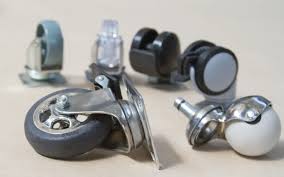
How Do Locking Wheel Casters Enhance Safety in Medical Equipment?
- 22 Feb, 2025
Introduction:
In medical environments, safety, stability, and mobility are paramount. This is especially true for the equipment that plays a critical role in patient care, such as hospital beds, medical carts, and diagnostic devices. A key component that contributes significantly to the functionality and safety of this equipment is the locking wheel caster. These casters not only facilitate smooth movement but also provide a secure, stationary base when needed. In this article, we will explore the importance of locking wheel casters in medical equipment, how they enhance safety, and the factors to consider when choosing the right ones for healthcare settings.
The Role of Locking Wheel Casters in Enhancing Safety
- Stability During Patient Care:
Hospital beds and medical carts are essential for patient care, often involving procedures or treatments where stability is critical. Locking wheel casters help prevent these pieces of equipment from moving unexpectedly, which can be particularly dangerous during patient transfers or when the equipment is being adjusted for a procedure. When the wheels are locked, the equipment remains stationary, ensuring that both the patient and healthcare provider are safe from any unintentional movement.
- Preventing Accidental Movement in High-Traffic Areas:
Hospitals and healthcare facilities are often bustling with activity, and medical equipment is frequently moved throughout the building. With locking wheel casters, medical carts and beds can be moved easily, but once in position, the caster locks ensure that the equipment does not inadvertently roll or shift. This is especially important when equipment is placed near walls, other furniture, or sensitive medical devices, where movement can lead to accidents or damage.
- Reducing the Risk of Injuries:
In healthcare settings, healthcare workers must often reposition heavy equipment or patients. Without locking casters, these actions could result in strains or injuries due to the instability of the equipment. Locking wheel casters help to mitigate this risk by ensuring the equipment remains firmly in place while staff reposition or interact with patients. The ease of locking and unlocking the wheels provides a secure foundation without requiring excessive force or awkward movements.
- Controlling the Mobility of Medical Equipment:
In some medical situations, controlling the movement of equipment is essential. For instance, when setting up medical carts in surgery rooms or ICU wards, locking casters prevent unnecessary rolling during the process of setting up tools or attaching equipment. Additionally, locking the casters ensures that the equipment stays in the designated spot during critical procedures, reducing any potential risk of errors or disruptions.
How Locking Wheel Casters Contribute to Ergonomics in Healthcare Settings
Ergonomics in healthcare is all about designing environments that reduce strain and enhance efficiency for both patients and staff. Locking wheel casters play an integral role in improving ergonomics by offering a safer, more controlled experience when interacting with medical equipment.
- Easier Maneuverability with Stability:
Locking casters help to combine the best of both worlds: the mobility needed to easily reposition equipment and the stability needed to keep it in place. Healthcare workers no longer need to worry about equipment moving unpredictably when it's not intended to. The flexibility of locking wheel casters allows workers to move equipment into position and then lock it with ease, preventing unnecessary back-and-forth motion.
- Reducing Risk of Falls and Injuries:
In facilities with patients who are at a higher risk of falls, such as elderly or injured patients, stability is paramount. Locking casters ensure that equipment, such as hospital beds and patient transfer devices, stays firmly in place when not in use. This helps to create a safer environment for both the patients and the healthcare workers, reducing the chances of falls or other types of injuries.
Selecting the Right Locking Wheel Casters for Medical Equipment
When choosing locking wheel casters for medical equipment, it is crucial to consider the following factors to ensure optimal safety and performance:
- Load Capacity:
Medical equipment varies greatly in weight, so it's essential to choose casters with a load capacity that matches the weight of the equipment they will be supporting. Overloading the casters can compromise their performance and safety, leading to instability or failure. Be sure to select casters with an appropriate weight rating for the equipment in question.
- Surface Compatibility:
Consider the type of flooring in your healthcare facility when selecting casters. Medical equipment may need to be moved over different types of surfaces, such as tile, carpet, or vinyl. Soft rubber or polyurethane casters are often ideal for smooth surfaces, while harder wheels may be necessary for more rugged flooring. Additionally, ensure the casters can roll smoothly without damaging the floor or leaving scuff marks.
- Locking Mechanism Type:
There are different types of locking mechanisms for casters, including total-lock (which locks both the wheel and the swivel) and directional-lock (which only locks the wheel’s rotation). Choose the locking mechanism based on the type of medical equipment and the required level of control. For example, total-lock casters might be better suited for hospital beds, while directional-lock casters might be more appropriate for medical carts.
- Ease of Use:
Healthcare environments are fast-paced, and locking and unlocking casters should be as efficient as possible. Ensure the locking mechanism is easy to engage and release without requiring excessive force. Consider foot-operated locking systems for healthcare workers who may need to use their hands for other tasks.
Conclusion:
Locking wheel casters play a crucial role in enhancing safety, stability, and mobility in healthcare environments. By providing a reliable way to prevent unintended movement and ensuring that medical equipment remains stationary when needed, they significantly reduce the risk of accidents, injuries, and errors. When selecting locking wheel casters, it's essential to consider factors like load capacity, surface compatibility, and ease of use to ensure the right fit for the medical equipment. Ultimately, investing in high-quality locking casters contributes to a safer and more efficient healthcare environment for both patients and staff.











